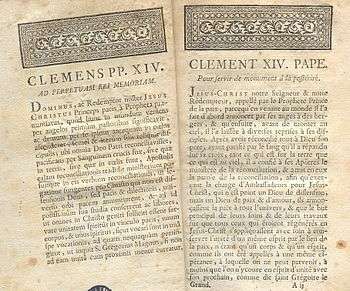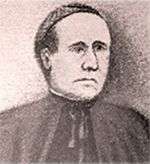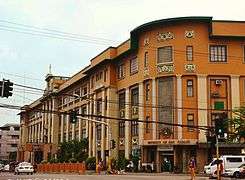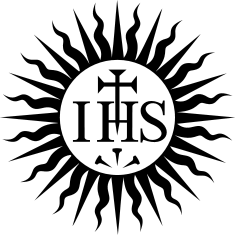Colegio de San Ildefonso
|
Seal of the Society of Jesus | |
| Type | Private |
|---|---|
| Active | 1595–1769 |
| Affiliation | Catholic Church (Jesuit) |
| Location |
|
The Colegio de San Ildefonso in Cebu City, the Philippines, is the first educational institution established in Asia by the Europeans. In Mexico City 1588, the Jesuits also founded a colegio with the same name.[1] The Cebu City colegio was established by Fr. Antonio Sedeno, Fr. Pedro Chirino, and Antonio Pereira of the Society of Jesus in 1595.[2] After the expulsion of the Jesuits from Spanish territories in 1767, the buildings and facilities were taken over first by the Diocese of Cebu, then the Congregation of the Mission, then later by the Society of the Divine Word.[2][3][4]
The University of San Carlos makes the claim of tracing its roots to San Ildefonso.[2] However, this claim is challenged by the Royal and Pontifical University of Santo Tomas, and by several other historians.[3][4]
Early History
In 1595, Fr. Antonio Sedeno, Fr. Pedro Chirino, and Antonio Pereira of the Society of Jesus established a grammar school attached to the Jesuit residence in Cebu City.[4] In 1606, it was officially named as the Colegio de San Ildefonso.[4] In 1608, it was reduced to a primary school for boys due to the lack of students as many Spanish residents left Cebu to settle in Manila.[2][3]
Suppression of the Society of Jesus

Dominus ac Redemptor
For a few years Clement XIV tried to placate the enemies of the Jesuits by treating them harshly: he refused to meet the Superior General, Lorenzo Ricci, ordered them not to receive novices, etc., to no avail. The pressure kept building up to the point that Catholic countries were threatening to break away from the Church. Clement XIV ultimately yielded "in the name of peace of the Church and to avoid of secession in Europe" and suppressed the Society of Jesus by the brief Dominus ac Redemptor on 21 July 1773.[5][6]
Expulsion of the Jesuits from the Philippines
The royal decree of King Charles III of Spain banishing the Society of Jesus from Spain and the Spanish dominions reached Manila on May 17, 1768. Between 1769 and 1771 the Jesuits in the Philippines were transported to Spain and from there deported to Italy. The Jesuits surrendered the San Ildefonso to Spanish civil authorities in 1768, thus closing the institution.[6][7]
Later Years



Colegio de San Ildefonso’s buildings were not demolished and were left to fall to ruin until Most Rev. Mateo Joaquin Rubio de Arevalo, bishop of Cebu, requested King Charles III of Spain on October 25, 1777 for the legal bequest of the land and building of the closed Colegio and use it for an institution exclusively devoted to the training of candidates to the priesthood in his diocese.[4][7]
The King’s decree dated October 29, 1779 granted the request and decreed the founding of a diocesan seminary to be called Real Seminario de San Carlos. But it was not until August 23, 1783 that the royal decree was executed and the administration of the seminary was given to the Diocesan Clergy of Cebu.[7] The Seminary became a mixed seminary, a seminary-college, offering courses to the candidates for the priesthood and, besides, some basic courses in humanities (then called latinidad) to non-boarding Cebuano kids.[3] In view of the delicate and demanding nature of seminary work that only a few diocesan priests were prepared to assume at the time, the Dominican Bishop of Cebu, Romualdo Jimeno, invited fellow Dominicans to lend the diocesan clergy a helping hand. From 1852 to 1867 scholars from Manila took turns in acting as professors and Regents of Studies. During this period the seminary shed off its royal identity when it became Seminario Conciliar de San Carlos, a diocesan seminary according to the rules laid down by the Council of Trent.[7]
When the Congregation of the Missions arrived in 1862 to administer the seminaries in the Philippine islands, Bishop Jimeno invited them on March 2, 1863 to take charge of the seminary. The request was fulfilled on January 23, 1867 with the arrival of the Congregation of the Mission or Padres Paules, as they were fondly called.[7] Finally, in May 15, 1867, Bishop Jimeno issued a drecree ordering the turnover of the school facilities and buildings to the congregation.[7] The Congregation turned it into a seminario-colegio, or a seminary with a program of secondary education for boys not intended for ecclesiastical service. In 1891 the seminary obtained recognition for its secondary education program and in 1893 it had a 5-year Bachelor of Arts curriculum under the supervision the University of Santo Tomas in Manila.[7] On July 1, 1867, Padre Jose Casarramona welcomed the first lay students to attend classes.[4] The Society of the Divine Word took over the college in 1935. It became a university in 1948.[2]
Controversies

The University of San Carlos makes the claim of tracing its roots to the Colegio de San Ildefonso founded by the Spanish Jesuits fathers Antonio Sedeno, Pedro Chirino and Antonio Pereira in 1595.[2] USC celebrated its quadricentennial in 1995.[2] This claim is opposed by the Pontifical and Royal University of Santo Tomas,[3][4] which argues that USC only took over the facility of the former Colegio de San Ildefonso and that there is no 'visible' and 'clear' link between San Carlos and San Ildefonso.[3][4]
Notable scholars including Dr. Jose Victor Torres, professor of history at the De La Salle University,[3][8] Fr. Aloysius Cartagenas STD, professor at the Seminario Mayor de San Carlos of Cebu[9][10] and Fr. Fidel Villarroel, OP, eminent historian and former archivist of Santo Tomas[4][11][12] have also questioned San Carlos' claim of tracing its roots to the 16th Century Colegio de San Ildefonso.[3][4]
References
- ↑ San Ildefonso College is called in Spanish Colegio de San Ildefonso.
- 1 2 3 4 5 6 7 University of San Carlos Website. University of San Carlos Website May 1, 2012.
- 1 2 3 4 5 6 7 8 No Contest, UST is Oldest. Inquirer Website May 1, 2012.
- 1 2 3 4 5 6 7 8 9 10 UST is Oldest, Period. Varsitarian Website May 1, 2012.
- ↑ "The Catholic Encyclopedia". "The Catholic Encyclopedia" May 1, 2012.
- 1 2 The First Hundred Years Of the Ateneo de Manila. The First Hundred Years Of the Ateneo de Manila" May 1, 2012.
- 1 2 3 4 5 6 7 Seminario Mayor de San Carlos website History and Heritage. Seminario Mayor de San Carlos Website May 1, 2012.
- ↑ Jose Victor Torres: Dramatizing History and Historicizing Drama. Montagemagazine Website May 1, 2012.
- ↑ Aloysius Cartagenas. linkedin.com May 1, 2012.
- ↑ SMSC Faculty Roster. Seminario Mayor de San Carlos May 1, 2012.
- ↑ UST Archives Director Fr. Fidel. Fidel Villarroel May 1, 2012.
- ↑ Evolution of Higher Education in the Philippines. Inquirer.net May 1, 2012.

